Abyssinian cats of a color of a color Sorrel: features of color and subtleties of leaving

Abyssinian cats are one of the oldest breeds. Their name comes from the ancient name of the African country of Ethiopia - Abyssinia. It is believed that from there they got to the territory of Ancient Egypt, where they became especially revered animals. The images of these cats on the tombs of the nobility and the sculptures preserved to this day leave no doubt that these are Abyssinian cats.
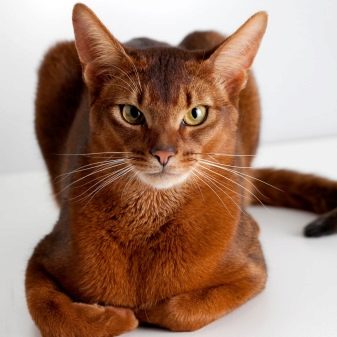
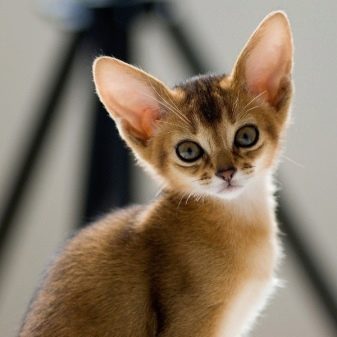
Breed history
The modern Abyssinian cat breed was formed in England. It is believed that one of the British soldiers brought these animals to his country from Africa. They were first presented to the public in 1871 at a cat show near London.
Nowadays, the international felinological organization CFA officially recognizes 4 main colors of this breed: wild, red or sorrel, blue and beige.
Interesting that Abyssinian cats of different colors give birth to babies not of a mixed shade, but of the color whose gene is dominant.
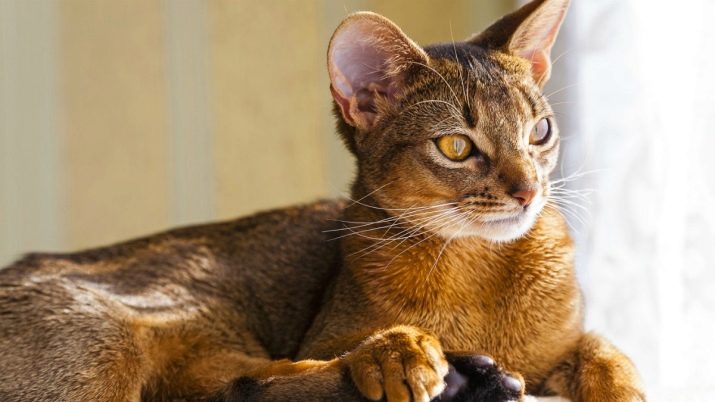
Appearance standard
The cat of this breed has a rounded muzzle, a long neck. Her ears are large, deep, dark at the ends (there are with tassels). The eyes are very expressive, shiny, almond-shaped, with dark eyeliner. The Abyssinians have a well-built muscular body with elongated limbs. The tail is rather long, thickened at the base, but tapering to the tip.
Animals are light in weight from 4 to 6 kilograms, which allows them to move easily and gracefully.
The height at the withers varies depending on the gender: in cats it is a maximum of 32 centimeters, and in cats - 28 centimeters.

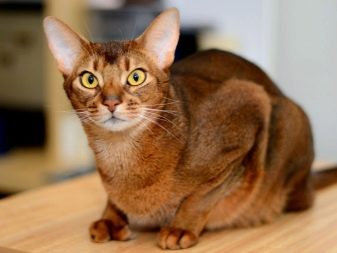
What is ticking?
When describing the color of the Abyssinians, one can often find the word “ticking”. It means that each hair in the hair of these cats is colored in alternating dark and light shades, which is due to the presence of a special agouti gene “A” in the genotype of this breed.
Ticking Abyssinian cats can be double (a combination of two colors) or triple, which is very rare.
According to its genotype, the cat of this breed is black, but under the influence of enzymes eumelanin, which is responsible for the black color, is oxidized and the shade becomes copper-brown.
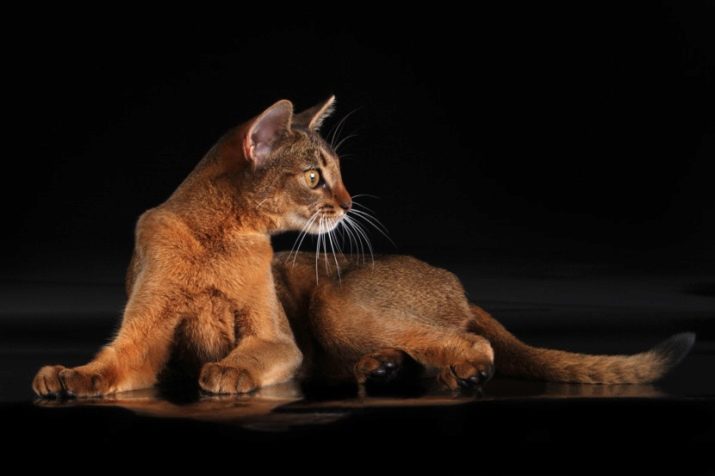
Abyssinians with copper wool
The color sorrel received official recognition in 1963, but until 1979 it was called red. These cats have a short wool coat of saturated copper color without a pattern and have a double ticking color of dark chocolate and cinnamon.
The disadvantage of this color is the presence of black hair in the coat.
On the inner surface of the legs and on the stomach, the areas of hair are lighter, the nose is pinkish, the pads on the legs are dark pink. Cats of this color have a characteristic red-brown strip running along the spine and a dark brown hue on the tail. The eyes are most often golden or copper colored, but individuals with walnut or green shades of the eyes can be found.

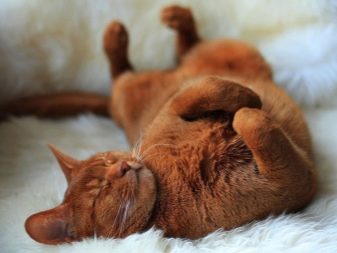
Keeping Adult Animals
Abyssinian cats are known for their activity, pleasant voice, balanced character, affection for the owner (cats are especially loyal). They easily remember all the rules of conduct in the house, neat and capricious.
In order to prevent diseases and hygiene, you should brush your cat’s teeth twice a month, comb out the hair regularly with a special brush, take care of your nails, and be vaccinated in a timely manner.
For normal development and growth Abyssinians need super premium food or a diet that includes boiled meat, sea fish, vegetables, dairy products, eggs. Cats of this breed You should not give raw duck and goose meat, lamb, pork, chicken and fish bones, sweets, salt and spices, sausages, canned food, potatoes and legumes.
Important! The genetic pathologies of this breed are polycystic kidney disease, blood diseases, gingivitis, retinal diseases, so you should pay special attention to the prevention of these diseases in your pet.



How to care for kittens?
Before you bring a kitten into the house, get everything you need: food bowls, claws, tray, house, toys; choose a quiet cozy corner for him. Abyssinian kittens need to play a lot and for a long time, they love sound toys and tall houses. Animals of this breed need a warm room with a temperature of at least +23 degrees Celsius, but this does not mean that they can be left outdoors for long periods in direct sunlight.
Make sure that the house does not have open needles, pins, tinsel, foil, or other small sharp objects that can cause injury to the kitten.
Do not forget to regularly inspect and clean the baby's eyes, ears, teeth, comb the hair, and get vaccinated on time.
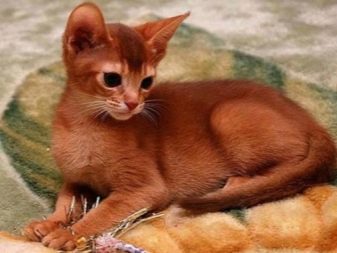

If you are going to feed the small Abyssinian with industrial feeds, then choose super-premium food. The kitten should always have fresh purified water in the drinker. With normal nutrition, it is useful for kittens to give the following foods:
- frozen raw beef;
- boiled offal;
- boiled chicken;
- sea fish;
- milk (up to three months);
- egg yolks;
- liquid cereals in milk;
- dairy products;
- vegetables;
- sprouted wheat.
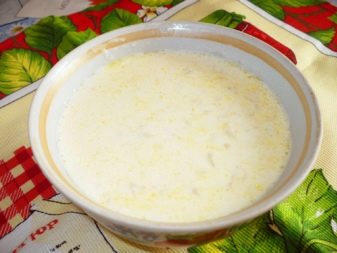
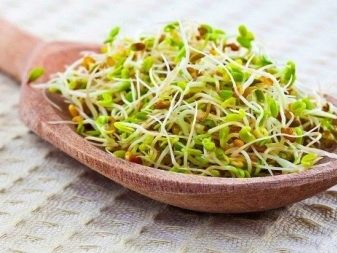
It should be noted that in small kittens of the Abyssinian breed, at first the hair is dull, but over time it acquires a beautiful and rich color.
Only by one and a half or two years in cats the color becomes pronounced, until that time the Abyssinian cat can change the color of the coat.
Abyssinian cats are graceful, intelligent and sociable animals. They easily get along with other pets, like games with children. With proper care, these amazing cats can live and delight you for decades.
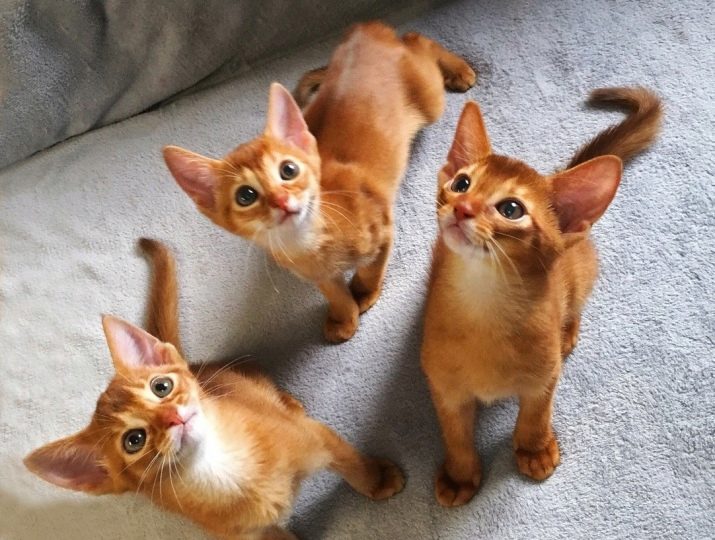
See below for general information about Abyssinian cats.





























